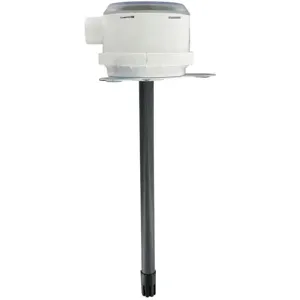Dwyer Instruments RHP-2D10 transmitter / transducer is designed for outdoor temperature & relative humidity reference, air economisers and pool room humidity monitoring. It offers high accuracy, long-term stability, flexibility and reliable operation.
Features:
- Dwyer Instruments RHP-2D10 relative temperature & humidity transducer / transmitter has NEMA 4X rated enclosure to protect against corrosion, splashing water and windblown dust or rain.
- It features polymer construction to resist condensation, high humidity, fog and contaminants.
- The unique design combines the voltage or current humidity transmitter output with a passive temperature thermistor or RTD output sensor.
- The Series RHP's cutting-edge sensor technology allows it to recover from 100 percent saturation and is completely calibration-free.
- Quick service and a decrease in full unit inventory are made possible by the field replaceable sensor and detachable filter of the unit.
- The metal mounting flange on this duct mount model shortens the time it takes to attach the transmitter to the duct.
- It can be ordered with just one current or voltage output for humidity or it can be factory customised also to have a voltage output, a passive RTD output or a temperature output using a thermistor. Without additional calibration, the RTD and thermistor outputs can be used interchangeably in the field.
Compatible Accessories:
- Dwyer A-449 Remote Displays: They are two-line alphanumeric LCD screens engineered for the user to easily read the temperature and humidity at once.
Standards and Approvals:
Frequently Asked Questions:
Q. How to install this relative humidity transducer?
A.
- Drill a hole in the duct at the desired location.
- Through the opening, insert the transmitter probe so that the mounting flange is flush with the duct.
- The mounting flange should be fastened to the duct with three 1/2-inch pan head sheet metal screws.
- Avoid over tightening.
- To access the wire terminals, remove the top screw cover.
Q. What are the important points to consider before installing this transmitter?
A.
- Before installation, disconnect the power source to avoid electrical shock and equipment damage.
- Precautions for electrostatic discharge should be used, such as wrist straps during wiring and installation to guard against equipment damage.
- Avoid areas where there is an excess of moisture, vibration or corrosive vapours.
- Do not exceed the electrical ratings.
- The relative humidity measurement of the transmitter should not be impacted by fans, corners, heating and cooling coils or other equipment.
- Additionally, it needs to be installed where it will receive enough airflow to function properly.
- To keep moisture out, the transmitter should be positioned so that the conduit connection faces downward.
Q. How to perform field sensor replacements?
A.
- Remove the plastic cover or sintered filter.
- Remove and discard old sensors.
- Replace the sensor, ensuring that all six pins mate correctly with the socket and that the boards are correctly aligned.
- Replace the plastic cover or sintered filter.




